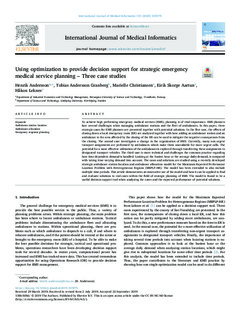| dc.contributor.author | Andersson, Henrik | |
| dc.contributor.author | Andersson Granberg, Tobias | |
| dc.contributor.author | Christiansen, Marielle | |
| dc.contributor.author | Aartun, Eirik Skorge | |
| dc.contributor.author | Leknes, Håkon | |
| dc.date.accessioned | 2020-02-12T08:01:40Z | |
| dc.date.available | 2020-02-12T08:01:40Z | |
| dc.date.created | 2019-11-04T15:25:23Z | |
| dc.date.issued | 2019 | |
| dc.identifier.issn | 1386-5056 | |
| dc.identifier.uri | http://hdl.handle.net/11250/2641179 | |
| dc.description.abstract | To achieve high performing emergency medical services (EMS), planning is of vital importance. EMS planners face several challenges when managing ambulance stations and the fleet of ambulances. In this paper, three strategic cases for EMS planners are presented together with potential solutions. In the first case, the effects of closing down a local emergency room (ER) are analyzed together with how adding an ambulance station and an ambulance to the area affected by the closing of the ER can be used to mitigate the negative consequences from the closing. The second case investigates a change in the organization of EMS. Currently, many non-urgent transport assignments are performed by ambulances which make them unavailable for more urgent calls. The potential for a more effective utilization of the ambulances is explored through transferring these assignments to designated transport vehicles. The third case is more technical and challenges the common practice regarding how time dependent demand is handled. Looking at the busiest hour or the average daily demand, is compared with taking time varying demand into account. The cases and solutions are studied using a recently developed strategic ambulance station location and ambulance allocation model for the Maximum Expected Performance Location Problem with Heterogeneous Regions (MEPLP-HR). The model has been extended to also include multiple time periods. This article demonstrates an innovative use of the model and how it can be applied to find and evaluate solutions to real cases within the field of strategic planning of EMS. The model is found to be a useful decision support tool when analyzing the cases and the expected performance of potential solutions. | nb_NO |
| dc.language.iso | eng | nb_NO |
| dc.publisher | Elsevier | nb_NO |
| dc.rights | Attribution-NonCommercial-NoDerivatives 4.0 Internasjonal | * |
| dc.rights.uri | http://creativecommons.org/licenses/by-nc-nd/4.0/deed.no | * |
| dc.title | Using optimization to provide decision support for strategic emergency medical service planning - Three case studies | nb_NO |
| dc.type | Journal article | nb_NO |
| dc.type | Peer reviewed | nb_NO |
| dc.description.version | publishedVersion | nb_NO |
| dc.source.volume | 133 | nb_NO |
| dc.source.journal | International Journal of Medical Informatics | nb_NO |
| dc.identifier.doi | 10.1016/j.ijmedinf.2019.103975 | |
| dc.identifier.cristin | 1743924 | |
| dc.description.localcode | © 2019 The Authors. Published by Elsevier B.V. This is an open access article under the CC BY-NC-ND license (http://creativecommons.org/licenses/BY-NC-ND/4.0/). | nb_NO |
| cristin.unitcode | 194,60,25,0 | |
| cristin.unitname | Institutt for industriell økonomi og teknologiledelse | |
| cristin.ispublished | true | |
| cristin.fulltext | original | |
| cristin.qualitycode | 2 | |

